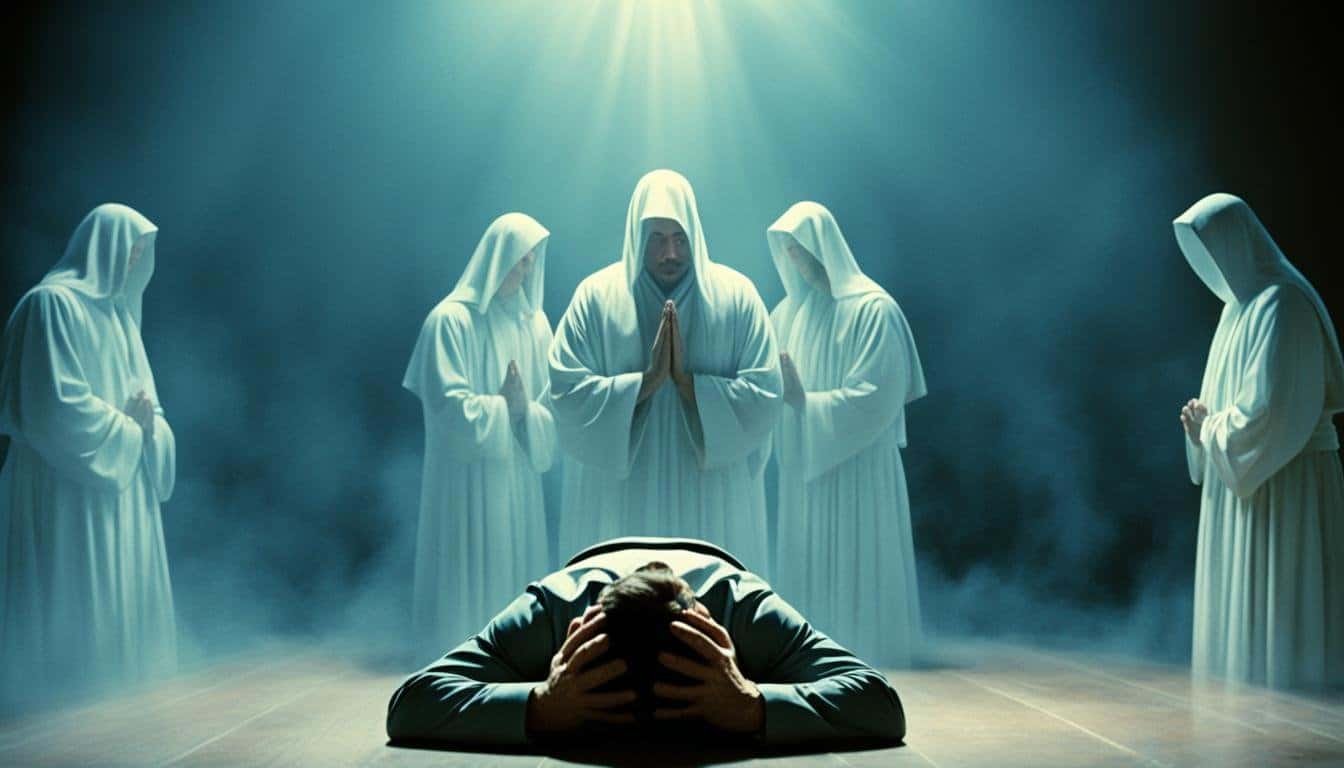Have you ever wondered what genuine repentance looks like? The book of Genesis has powerful stories of people who admitted their mistakes. They then started on a journey to make things right. These stories teach us amazing lessons about confessing our wrongs and changing our ways.
Stories range from Adam and Eve admitting their sin to Cain showing fear and regret after he killed Abel. Genesis is full of stories where people do more than just feel bad. They show us what true repentance is by trying to fix things. Let’s take a closer look at these powerful tales of change.
Key Takeaways:
- Genesis has many stories about real change, giving lessons for our own lives.
- Adam and Eve’s confession and Cain’s worry are examples of true repentance.
- Noah’s faith and Abraham’s trust show real change in action.
- Even Hagar’s obedience and Lot’s wife’s partial change highlight different ways to seek forgiveness.
- Abimelech’s making things right, Jacob’s spiritual struggle, and Esau and Leah’s forgiving attitude set great examples of turning back to God.
Let’s delve into these stories of real repentance in Genesis. We’ll see how they can change our lives by inspiring us to admit our wrongs and seek to do better.
Adam and Eve – Confessing their Sin
Adam and Eve lived in paradise in the Garden of Eden. Yet, they had to make a tough choice. They chose to eat from a tree God told them not to.
Instead of trying to hide their mistake, they chose to own up to it. This showed that they truly felt sorry for what they did.
Adam said, “I heard You in the garden and got scared because I was naked. So, I hid.” He then told God, “The woman You gave me, she gave me the fruit, and I ate it.”
Eve did not blame anyone else. She said, “The snake tricked me, and I ate.”
This moment was crucial. Adam and Eve showed how much they regretted their actions. They confessed, hoping for forgiveness and to fix things with God.
Their honest admission proved they were humble. They also showed they were ready for whatever came next. This honesty set the stage for their path to making things right.
Cain – Fear and Concern
After killing his brother Abel, Cain felt immediate guilt. The thought of his tragic mistake scared him. He feared not just for his safety but also for what it meant to have killed someone.
Knowing the weight of his sin, Cain humbly asked God for forgiveness. His plea showed real sorrow and a deep awareness of his crime. Although worried about his life, his main concern was making things right with God.
God was fair, yet kind to Cain. Despite his punishment, God protected him from harm with a special mark. This event shows a merciful God who welcomes those who truly seek change, even after doing something terribly wrong.
“My punishment is greater than I can bear! Behold, You have driven me this day away from the ground, and from Your face I shall be hidden. I shall be a fugitive and a wanderer on the earth, and whoever finds me will kill me.” – Genesis 4:13-14
Cain’s story shows a man transformed by deep remorse. He understood the seriousness of his mistake and yearned for God’s forgiveness. His remorse was evident in his heartfelt prayer and admission of guilt.
The Impact of Cain’s Repentance
Cain’s tale warns about the heavy price of sin and the need for true repentance. He teaches us that recognizing our faults and seeking forgiveness are key steps to making things right. This journey underscores the value of remorse and asking for mercy.
We all stumble and make mistakes like Cain. Yet, in turning to God with genuine sorrow, we can find a way back. Through humble repentance, we pave a path to renewal, healing, and a closer walk with God.
Cain’s narrative encourages us. It reminds us that real repentance leads to grace, forgiveness, and reconciliation with God. Let’s remember his story, especially during our darkest hours, as a beacon of hope for a fresh start.
| Key Points: |
|---|
| Genuine repentance involves acknowledging the severity of one’s actions. |
| Fear and concern can serve as catalysts for seeking genuine repentance. |
| God’s justice and mercy are evident in His response to Cain’s repentance. |
| Cain’s journey teaches the importance of sincere repentance and seeking God’s forgiveness. |
Noah – Obedience and Faith
In Noah’s time, few were righteous in a world full of corruption. Noah, by contrast, shone brightly with his unmatched faith in and obedience to God. When God told him to build an ark for the great flood, Noah didn’t think twice.
Noah worked hard, following God’s instructions to the letter even as others mocked him. He showed his true faith by believing in God’s guidance and wisdom despite opposition. His actions spoke volumes about his devotion to God and his willingness to obey.
“Obedience and faith go hand in hand,” Noah often said. “We must be ready to follow God’s lead, believing in His promises, however hard the task ahead might seem.”
Noah’s acts of obedience and faith were more than just obedience; they were heartfelt. He found comfort in knowing his actions would not only save his family but also protect all life on Earth.
Building the Ark – A Testament of Obedience
Noah faced many tests as he built the ark. Every step, from collecting materials to following precise instructions, proved his unwavering obedience.
With every measurement, cut, and nail, Noah’s deep faith never wavered. Even in the face of doubt and criticism, his actions showed his strong belief in God.

A Lesson in Faith
In a fallen world, Noah’s faith and obedience were a beacon of light. His commitment to following God’s commands and faith in His promises was a powerful witness. It showed how true repentance can completely change a person’s life.
Noah’s story teaches us that obedience and faith mean more than just doing what God says. They are deep signs of our connection to God. They require us to trust, give up our will, and always seek to follow God’s path.
Thinking about Noah’s strong faith and obedience, we should work on these qualities in our own lives. By truly turning to God, obeying Him, and having faith, we lay a strong foundation. It leads to the blessings and peace from living a life that follows God wholeheartedly.
Abraham – Returning to Trust
In the book of Genesis, we learn about Abraham’s journey. He once lied that his wife was his sister. He did this to keep himself safe. This lie showed he doubted God’s protection and care. Yet, Abraham changed. He truly felt sorry for his mistake and learned to trust God again.
The Test of Faith
Abraham faced a big challenge with his son Isaac. God asked him to sacrifice Isaac. This was very hard for Abraham. But he chose to trust God and obey.
As Abraham was about to sacrifice Isaac, an angel stopped him. They found a ram to sacrifice instead. This showed Abraham that God is always faithful and provides a way.
“Abraham returned to trusting in God’s protection and provision.”
The Covenant Renewed
After this test, God made a special promise to Abraham again. He said his descendants would be many, like stars. This promise changed Abraham. He fully trusted God once more.
Abraham admitted his fear and doubts to God. He stopped depending on his own cleverness. Instead, he chose to trust in God’s guidance and protection. This was a major step in Abraham’s new way of living.
A Table: Abraham’s Journey of Genuine Repentance
| Key Actions | Abraham’s Response | Result |
|---|---|---|
| Lied about Sarah | Abraham’s lack of trust | Exposed vulnerability |
| Test of faith with Isaac | Obeyed God’s command | Renewed trust and faithfulness |
| Covenant reaffirmed | Confessed fear and doubt | Returned to complete trust in God |
Abraham’s story of turning back to God can encourage us. It shows us that we, too, can change. When we stop relying on ourselves and start trusting God’s love and faith, amazing things can happen.
Hagar – Returning and Following Instructions
In the book of Genesis, we learn about Hagar. She faced mistreatment from Sarai and decided to run away. But something amazing happened on her journey.
While escaping, an angel met Hagar. The angel told her to go back and obey what God wanted.
Instead of staying angry or seeking payback, Hagar followed through. She showed she was truly sorry and wanted peace.
“Return to your mistress and submit to her.” – Genesis 16:9
This turning point changed Hagar. She agreed to play her part in God’s big story. Going back to Sarai was a way for her to make up for what had gone wrong.
By obeying God, Hagar found new faith. She saw that God cared, even in her tough times. This trust changed everything for her.
Hagar’s story tells us that fixing mistakes is more than saying sorry. It’s about acting on what we know is right. Her experience pushes us to make peace and have faith in God.

| Key Elements | Description |
|---|---|
| Repentance | Hagar’s decision to return to Sarai reflects her genuine repentance for her actions. |
| Obedience | In following God’s instructions given through the angel, Hagar demonstrates her obedience and faith. |
| Restoration | Hagar’s return paves the way for reconciliation with Sarai and a renewed relationship with God. |
| Trust | By following God’s guidance, Hagar exhibits her trust in His plan and purpose for her life. |
Lot’s Wife – Momentary Compliance
In Genesis, the story of Lot’s wife is a cautionary tale. It highlights how she initially obeyed the angels but later disobeyed.
Lot’s wife and her family listened to the angel and left sinful Sodom. They showed readiness to flee from destruction. Yet, Lot’s wife couldn’t keep up her obedience in the end.
As they ran, she looked back at the city. By doing this, she showed she wasn’t fully ready to leave its sinful life. This act of disobedience cost her life, turning her into a pillar of salt.
This story is a lesson in true repentance. It’s more than just a quick obedience, requiring a deep commitment to leave sin behind. Lot’s wife fell because her repentance wasn’t complete and lasting.

The Consequences of Momentary Compliance
“Remember Lot’s wife.” – Luke 17:32
Lot’s wife’s fate warns us. She seemed to obey for a moment, but her disobedience was stronger. It shows we need to truly turn away from sin to avoid its consequences.
The Call for Genuine Repentance
Her story asks us to check our repentance. Do we just obey God for a moment or are we truly sorry and eager to do right? Let’s truly repent like she was called to, letting go of sin totally.
Abimelech – Restoring and Making Restitution
The book of Genesis tells a powerful story about Abimelech. It’s about true sorrow and fixing mistakes. He was the king of Gerar. Abimelech took Sarah, Abraham’s wife, thinking she was single. God then let him know through a dream.
When Abimelech knew the truth, he acted fast. He returned Sarah to Abraham. He also gave gifts to show how sorry he was. This was more than just saying sorry. It was about making things right.
“What have you experienced that made you think, or even know, you have to make it right? What restitution have you made in your life?”
Abimelech teaches us to own up to our mistakes. To really change, we need to do more than apologize. We must work to fix what we’ve broken. This means making things right with others.
Restoring what we’ve ruined is key. It shows we’re serious about change. It’s not just between us and God. It’s about those we’ve hurt too. This rebuilding shows we’re truly sorry.
| How Abimelech Demonstrated Genuine Repentance | Why It Matters |
|---|---|
| 1. Restored Sarah to Abraham | By bringing back Sarah, he honored Abraham’s marriage. |
| 2. Made restitution | His gifts to Abraham showed Abimelech’s deep regret and his wish to be forgiven. |
| 3. Accepted responsibility | He didn’t blame others. Abimelech took responsibility and made things right. |
Abimelech calls us to think about our own actions. How can we fix our mistakes? It’s not just about saying sorry. It’s about real change through action. By doing our part to make up for our wrongs, we heal relationships.

Jacob – Wrestling with God and Seeking Blessing
In Genesis, we see Jacob’s profound change after his trick with his father Isaac. This trick led to Jacob getting the blessing meant for his brother Esau.
Jacob’s change starts when he struggles with God. This key moment shows his deep wish for God’s blessing. It also shows his courage to face the things he did.
During this fight, Jacob shows great physical and spiritual strength. He holds on until he gets a blessing from God. This shows his strong desire for change and healing. Jacob’s fight reflects his inner battles over his past actions and identity.
Jacob works hard to change his path from deceit to humility. He truly acknowledges his wrong choices. Jacob is ready to accept God’s grace and forgiveness.
“I will not let you go unless you bless me.” – Genesis 32:26
This statement shows Jacob’s drive to make peace with God and earn His favor. It’s a crucial moment where Jacob admits his need for God. He starts to make profound changes seeking God’s favor with all his heart.
The Blessing
God’s blessing to Jacob shows God’s willingness to forgive and bless. In this act, God recognizes Jacob’s true desire for change. He even gives Jacob a new name – Israel which means “one who struggles with God.”
Esau and Leah – Forgiveness and Turning Back to God
Esau and Leah were seen as characters who went through big changes in Genesis. Both of them forgave and turned back to God in inspiring ways. Esau was angry at his brother Jacob but decided not to take revenge. He chose to be friends with Jacob instead.
Leah did something similar. She tricked Jacob when they got married. But, later, she showed that she wanted to follow God. She named her fourth son Judah to honor God in a special way.
Esau and Leah teach us about true change and forgiveness. They show how important it is to make things right with God. They prove that we can all get past our mistakes and improve our relationship with God.
Their stories help us think about our own lives. Do we need to ask for forgiveness or forgive someone else? Have we gone away from what God wants for us? These tales remind us to follow in their footsteps by being truly sorry, forgiving, and always coming back to God.
Affiliate Disclosure: "As an Amazon Associate I earn from qualifying purchases made from links in this post. We are a participant in the Amazon Services LLC Associates Program, an affiliate advertising program designed to provide a means for us to earn fees by linking to Amazon.com."

